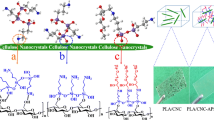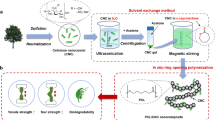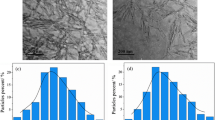Abstract
Cellulose nanocrystals (CNCs) produced by sulfuric acid hydrolysis as organic nanofillers were dispersed into polycarbonate (PC) in organic solution through a solvent exchange procedure, and their influence on the optical, mechanical, and thermal properties of the resulting composite films were studied. It is demonstrated that due to the good dispersion of the nanofillers in the polymeric matrix, the formation of strong hydrogen bonds between carbonyl groups of PC and hydroxyl groups of the CNCs can be achieved, leading to a simultaneous reinforcement effect on mechanical and thermal properties of the composite films. Moreover, it was further found that the existence of nanofillers in the composite efficiently hindered the main thermal degradation pathways of PC involving the chain scission at carbonate linkage and rearrangement of carbonate groups. Compared with neat PC, the composite film with 3 wt% CNCs has an increase of about 30.6 % in tensile strength, 27.3 % in Young’s modulus, and 3.3 % in maximum decomposition temperature, but still remain quite transparent.





Similar content being viewed by others
References
Althues H, Henle J, Kaskel S (2007) Functional inorganic nanofillers for transparent polymers. Chem Soc Rev 36:1454–1465
Capadona JR, Berg OVD, Capadona LA, Schroeter M, Rowan SJ, Tyler DJ, Weder C (2007) A versatile approach for the processing of polymer nanocomposites with self-assembled nanofibre templates. Nat Nanotechnol 2:765–769
Dahman Y, Oktem T (2012) Optically transparent nanocomposites reinforced with modified biocellulose nanofibers. J Appl Polym Sci 126:E188–E196
Dong H, Strawhecker KE, Snyder JF, Orlicki JA, Reiner RS, Rudie AW (2012) Cellulose nanocrystals as a reinforcing material for electrospun poly(methyl methacrylate) fibers: formation, properties and nanomechanical characterization. Carbohydr Polym 87:2488–2495
Fei B, Chen C, Wu H, Peng S, Wang X, Dong L (2003) Quantitative FTIR study of PHBV/bisphenol A blends. Eur Polym J 39:1939–1946
Hakimelahi HR, Hu L, Rupp BB, Coleman MR (2010) Synthesis and characterization of transparent alumina reinforced polycarbonate nanocomposite. Polymer 51:2494–2502
Hameed N, Guo Q, Tay FH, Kazarian SG (2011) Blends of cellulose and poly(3-hydroxybutyrate-co-3-hydroxyvalerate) prepared from the ionic liquid 1-butyl-3-methylimidazolium chloride. Carbohydr Polym 86:94–104
He Y, Inoue Y (2000) Novel FTIR method for determining the crystallinity of poly(ε-caprolactone). Polym Int 49:623–626
Heymans N, Rossum SV (2002) FTIR investigation of structural modifications during low-temperature ageing of polycarbonate. J Mater Sci 37:4273–4277
Ifuku S, Morooka S, Nakagaito AN, Morimoto M, Saimoto H (2011) Preparation and characterization of optically transparent chitin nanofiber/(meth)acrylic resin composites. Green Chem 13:1708–1711
Imai Y, Terahara A, Hakuta Y, Matsui K, Hayashi H, Ueno N (2009) Transparent poly(bisphenol A carbonate)-based nanocomposites with high refractive index nanoparticles. Eur Polym J 45:630–638
Jang BN, Wilkie CA (2004) A TGA/FTIR and mass spectral study on the thermal degradation of bisphenol A polycarbonate. Polym Degrad Stab 86:419–430
Kumara A, Depana D, Tomer N, Singh R (2009) Nanoscale particles for polymer degradation and stabilization—trends and future perspectives. Prog Polym Sci 34:479–515
Lee KM, Han CD (2003) Effect of hydrogen bonding on the rheology of polycarbonate/organoclay nanocomposites. Polymer 44:4573–4588
Levchik SV, Weil ED (2005) Overview of recent developments in the flame retardancy of polycarbonates. Polym Int 54:981–998
Liu HY, Liu DG, Yao F, Wu QL (2010) Fabrication and properties of transparent polymethylmethacrylate/cellulose nanocrystals composites. Bioresour Technol 101:5685–5692
Lu P, Hsieh YL (2010) Preparation and properties of cellulose nanocrystals: rods, spheres, and network. Carbohydr Polym 82:329–336
Moon RJ, Martini A, Nairn J, Simonsen J, Youngblood J (2011) Cellulose nanomaterials review: structure, properties and nanocomposites. Chem Soc Rev 40:3941–3994
Nogi M, Hiroyuki Yano H (2008) Transparent nanocomposites based on cellulose produced by bacteria offer potential innovation in the electronics device industry. Adv Mater 20:1849–1852
Nogi M, Handa K, Nakagaito AN, Yano H (2005) Optically transparent bionanofiber composites with low sensitivity to refractive index of the polymer matrix. Appl Phys Lett 87: 243110
Okahisa Y, Abe K, Nogi M, Nakagaito AN, Nakatani T, Yano H (2011) Effects of delignification in the production of plant-based cellulose nanofibers for optically transparent nanocomposites. Comp Sci Technol 71:1342–1347
Salim NV, Hameed N, Guo Q (2009) Competitive hydrogen bonding and self assembly in poly(2-vinyl pyridine)-block-poly(methyl methacrylate)/poly(hydroxyether of bisphenol A) blends. J Polym Sci B Polym Phys 47:1894–1905
Salim NV, Hanley T, Guo Q (2010) Microphase separation through competitive hydrogen bonding in double crystalline diblock copolymer/homopolymer blends. Macromolecules 43:7695–7704
Ten E, Turtle J, Bahr D, Jiang L, Wolcott M (2010) Thermal and mechanical properties of poly(3-hydroxybutyrate-co-3-hydroxyvalerate)/cellulose nanowhiskers composites. Polymer 51:2652–2660
Valmikanathan OP, Ostroverkhova O, Mulla IS, Vijayamohanan K, Atre SV (2008) The effect of synthesis procedure on the structure and properties of palladium/polycarbonate nanocomposites. Polymer 49:3413–3418
Wang J, Montville D, Gonsalves KE (1999) Synthesis of polycarbonate-co-poly(p-ethylphenol) and CdS nanocomposites. J Appl Polym Sci 72:1851–1868
Yu HY, Qin ZY, Liu YN, Chen L, Liu N, Zhou Z (2012) Simultaneous improvement of mechanical properties and thermal stability of bacterial polyester by cellulose nanocrystals. Carbohydr Polym 89:971–978
Acknowledgments
We greatly acknowledge financial support from Specialized Research Fund for the Doctoral Program of Higher Education (200802551024), the Fundamental Research Funds for the Central Universities (11D10612, 12D10610), and the Doctorate Innovation Foundation of Donghua University (BC201101).
Author information
Authors and Affiliations
Corresponding authors
Rights and permissions
About this article
Cite this article
Xu, W., Qin, Z., Yu, H. et al. Cellulose nanocrystals as organic nanofillers for transparent polycarbonate films. J Nanopart Res 15, 1562 (2013). https://doi.org/10.1007/s11051-013-1562-0
Received:
Accepted:
Published:
DOI: https://doi.org/10.1007/s11051-013-1562-0




